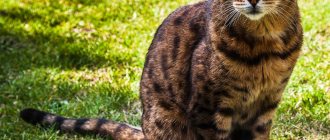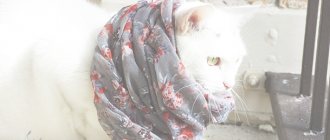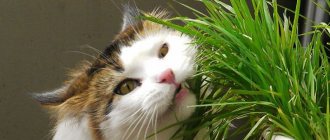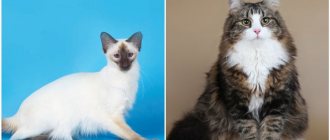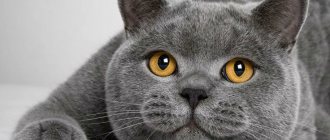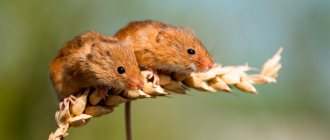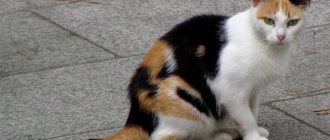Which cats catch mice and rats: heredity and upbringing
Half a century ago, an experiment took place in which cats and kittens were involved. Two “families” were purebred, and two were “noble families” living in rural conditions. The cats were replaced with babies, giving them to simple purebred cats and vice versa. When the kittens were about three weeks old, the village cats began teaching the children how to hunt in practice by bringing them mice they had caught.
The little “nobles”, under the leadership of high-born “mothers” at that time, were simply playing at hunting; they did not have the need, and indeed the opportunity, to kill the victim. As a result, it turned out that which cats catch mice and rats is influenced not only by heredity, but also by upbringing. The living example of a hunting cat, free access to prey, and the need to get food for oneself play no less a role than the genes in which hunting talent is embedded.
So, if you are wondering which cats catch mice, not out of idle curiosity, and you actually need a good mouser or mousetrap, pay attention to kittens born and raised in nature. Perhaps, somewhere in the basement, a cat is already raising for you someone who can easily rid your house of harmful rodents. If it is important for you that your mouse-catching pets have a breed, it is better to take kittens from a country nursery, where the cats have the opportunity to freely enter the area.
Is the Bengal cat a cat?
This cat was very beautiful, but with her own wild disposition. Jane was very surprised to notice the first symptoms of a cat's pregnancy, and when the kittens were born, very similar to their wild mother, but just as affectionate and sociable as their father, an ordinary domestic cat, Jane came up with the wonderful idea of creating a breed that would be as similar as possible to wild, but at the same time retained all the charming qualities of a domestic cat.
The first generation of hybrids still retained the wild habits of their ancestors. The first Bengals at shows were the first generations of F1, which is why the myth arose that the Bengal cat is wild, angry and aggressive. It was only in 1991 that the Bengal cat acquired official status in the cat breeds.
At the moment, this breed is still rare and one of the most expensive breeds in the world. There are many colors and colors of Bengals: snow, silver, gold, charcoal, blue, with rosettes, spots or beautiful lace marble, which is called Marble in this breed. Cats of this breed are very sociable and follow their owner everywhere to participate in all his affairs. They are incredibly playful and remain so until old age. Bengals are very mobile, and it is not difficult for them to jump onto the top of a door or cabinet, which is why future parents of a Bengal kitten are advised to buy a cat center for their pet. The hunting instinct of this breed is very developed, so you need a lot of different toys. Bengals also differ from ordinary domestic cats in their love for water; they play in it and bathe with pleasure.
This breed also has a distinctive sign, knowing which you will never be deceived when buying a kitten: this is glitter - the extraordinary shine of the fur, it seems to be sprinkled with small golden sparkles that burn and shine in the sun. The Bengal breed is distinguished by its sociable disposition; these cats get along well with dogs and even become best friends with them. This breed is also called a cat dog; they are very trainable, perform tricks and carry different things in their teeth.
In a very short period of time during the existence of this extraordinary breed, unfortunately, a number of misconceptions about Bengals :
1. This is an aggressive and wild cat. This is wrong! As stated above, these are incredibly affectionate, kind and sociable animals.
2. The Bengal cat is very big and therefore eats a lot. Cats grow to medium sizes - from 3 to 5 kg. Males are slightly larger - from 6 to 8 kg. At the same time, they eat the same way as a regular domestic cat.
3. The price of Bengals is determined by the greed of breeders. Keeping a breeding cat of the Bengal breed is quite difficult due to constant territory markings, so most Bengals are bought for castration and sterilization. In addition, good producers have to be imported from abroad; this is quite difficult, time-consuming and expensive. The price is due to the difficulty of breeding and the rarity of reproductive individuals.
When buying a Bengal kitten, you need to remember that first of all it is just a child who needs your attention, love and affection, and only then it is a purebred, exclusive, rare animal.
Tags: cat breed, cats, pets, pets
Cat or cat: who is the better hunter?
If we talk about the gender of mousecatchers, it still seems more reasonable to give the palm to the cat. In cats, the sexual instinct comes first, and if the animal is not castrated, the mustachioed cat can be distracted by “love” all year round, neglecting his hunting duties. We have all seen how skinny and tattered the tailed gentlemen return from their sexual adventures - it is obvious that they had no time for mice.
In cats, the estrus period is usually not long. And, raising kittens, as we said above, they hunt with double zeal and teach their offspring to do so. That is, they have double motivation. And female creatures usually have more persistence and diligence.
at home!
* Consultation is absolutely free
Proper nutrition is the key to good health for your cat.
This is a very important aspect of keeping a pet that should not be neglected. After all, only healthy and nutritious nutrition can provide the kitten’s body with all the necessary substances and reliable immunity.
Bengal cats, like most domestic cats, are suitable for two diets:
NATURAL NUTRITIONADVANTAGES:
FLAWS:
| DRY FOODADVANTAGES:
FLAWS:
|
Which cat catches mice better: beauty matters
The appearance of the mousetrap, if you think about it, also matters. After all, the hunter’s color is his camouflage, which should help the animal remain invisible for as long as possible. For our nature, a discreet fur coat would be preferable - gray, black, brown with stripes or spots, or motley, which will easily blend into any landscape.
It is worth paying attention to the length of the fur - long, when wet, its strong smell can “inform” the prey that a predator is approaching. Therefore, it is easier for short-haired cats to hunt in the rain.
And, of course, you need to pay attention to the whiskers, because these are, so to speak, the second eyes for the cat. Thanks to them, she navigates in the dark, estimates the distance to the target, and catches the slightest vibrations in the air. So, in the past, kittens were chosen based on their rich whiskers for good reason - this is both benefit and beauty in one bottle.
What breed of cat catches mice and rats?
The fame of outbred cats as the terror of rats and mice is well founded. After all, for them hunting is not just entertainment, but a way of survival. Healthy genes, not spoiled by close ties, ensure not only the transmission of hunting talent, but also physical endurance - a mandatory guarantee of victory over the enemy.
If we talk about purebred animals, then when discussing which breeds of cats catch mice, first of all we need to talk about the so-called aboriginal breeds. They naturally formed in a particular territory without the intervention of breeders, that is, they were bred by nature itself with all the ensuing advantages.
Among the “Russians” these are Siberian cats, Russian Blues, and Kuril Bobtails. Of those that have foreign roots, it is worth noting the giants Maine Coons, Orientals, Bengals, Abyssinians, Ocicats, Thais and Siamese, Chartreux, European and British Shorthairs - these cat breeds are also very, very deft at catching mice.
Breed of cats that catch mice: fact or fiction?
However, it still seems not entirely correct to discuss what breed of cats catch mice. A cat is a cat, and the hunting instinct lives in each of them. Everything else is extremely individual. Some street cats will prefer to rummage through the trash without straining themselves, while a pet that has grown up “in silks and velvet” and is hung with awards will eagerly catch every midge that may be lying around.
By the way, hunger, contrary to popular belief, is not a hunter’s best companion. A hungry animal is more impatient and makes mistakes more often than one that has no need to rush.
In short, there is no ideal cat breed for catching mice, just as there is no one that does not catch mice. There is a cat or cat - a hunter of rats and mice, and the breed has nothing to do with it. If you are lucky enough to meet one, take care of him, regardless of whether he has a pedigree or not. It is, without exaggeration, vital to vaccinate, treat for fleas and deworm such a treasure in a timely manner.
When contacting rodents, the risk of infection is very high. In addition, “city” mice and rats can be poisoned with poisons, and this can lead to poisoning of the cat. So the well-being of your pet hunter needs to be kept under special control.
Main breeds of rat catchers
Independent hunters are representatives of the Russian Blue breed. They become attached to only one owner, whom they are ready to protect from rodents. Athletic athletes - Chartreux cats - have a beautiful athletic physique, which helps in catching rats and mice.
Maine Coon
This ratcatcher cat is the largest breed; it is an intelligent and selective animal - a good hunter. The Maine Coon reacts with lightning speed to a rodent, and its powerful body and dexterous movements leave no chance for rats and mice. At the same time, he is a sweet and gentle creature who will purr with pleasure in his owner’s ear.
Siberian
The Siberian cat rarely becomes attached to humans, perhaps it has the “wild” blood of its ancestors. This balanced and powerful animal is considered the best rat hunter. Freedom is very important for an obstinate pet; the cat wants to walk outside from time to time. The Siberian cat is capable of developing great speed in running and jumping well. In addition, the animal has an excellent reaction.
European
The cat was common in ancient Rome. She copes well with the duties of a rat catcher. Each representative of this breed is an individual. The animal has a silver marbled or gray color.
Kurilian Bobtail
The animal was brought to us from the Kuril Islands. By their nature, the fluffies of this breed are similar to dogs. The little kitten quickly becomes attached to its owner and tries to take care of him.
The Kurilian Bobtail has a small tail. The cat has elongated and powerful hind limbs, which allow him to jump and develop great speed while running. The Bobtail can cope with any rat's home.
Siamese
Humans have nothing to do with the breeding of this breed. Siamese cats are fast and graceful. They have a very well developed hunting instinct.

